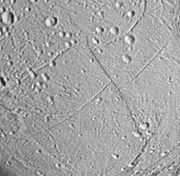
Isbanir Fossa
Encyclopedia

Escarpment
An escarpment is a steep slope or long cliff that occurs from erosion or faulting and separates two relatively level areas of differing elevations.-Description and variants:...
on Saturn
Saturn
Saturn is the sixth planet from the Sun and the second largest planet in the Solar System, after Jupiter. Saturn is named after the Roman god Saturn, equated to the Greek Cronus , the Babylonian Ninurta and the Hindu Shani. Saturn's astronomical symbol represents the Roman god's sickle.Saturn,...
's moon Enceladus
Enceladus (moon)
Enceladus is the sixth-largest of the moons of Saturn. It was discovered in 1789 by William Herschel. Until the two Voyager spacecraft passed near it in the early 1980s very little was known about this small moon besides the identification of water ice on its surface...
. Isbanir Fossa was first seen in Voyager 2
Voyager 2
The Voyager 2 spacecraft is a 722-kilogram space probe launched by NASA on August 20, 1977 to study the outer Solar System and eventually interstellar space...
images, though a small section was see at much higher resolution by Cassini. It is centred at 12.6° North Latitude
Latitude
In geography, the latitude of a location on the Earth is the angular distance of that location south or north of the Equator. The latitude is an angle, and is usually measured in degrees . The equator has a latitude of 0°, the North pole has a latitude of 90° north , and the South pole has a...
, 354.0° West Longitude
Longitude
Longitude is a geographic coordinate that specifies the east-west position of a point on the Earth's surface. It is an angular measurement, usually expressed in degrees, minutes and seconds, and denoted by the Greek letter lambda ....
and is approximately 132 kilometres long. Based on photoclinometric
Photoclinometry
Photoclinometry is the process by which a 2-dimensional image of a surface is transformed into a surface map that represents different levels of elevation. It uses the shadows and light direction as reference points. It is used mostly to depict the surface of sculptures, to give an idea of how it...
analysis of Voyager 2 images (using topographic shading in an image to determine slope), like the one at right, Isbanir Fossa was determined to be a 300-metre tall, west-dipping scarp (Kargel and Pozio 1996). Two sets of troughs can be seen running perpendicular to Isbanir Fossa, like Daryabar Fossa
Daryabar Fossa
Daryabar Fossa is an east-west trending trough on Saturn's moon Enceladus. Daryabar Fossa was first seen in Voyager 2 images, though a small section was see at much higher resolution by Cassini. It is centered at 9.7° North Latitude, 359.1° West Longitude and is approximately 201 kilometers long...
. These troughs appear to be right-laterally offset 15–20 km east and west of Isbanir Fossa, suggesting that the scarp may be a strike-slip fault or even a transform fault
Transform fault
A transform fault or transform boundary, also known as conservative plate boundary since these faults neither create nor destroy lithosphere, is a type of fault whose relative motion is predominantly horizontal in either sinistral or dextral direction. Furthermore, transform faults end abruptly...
with troughs like Daryabar Fossa representing spreading centres
Seafloor spreading
Seafloor spreading is a process that occurs at mid-ocean ridges, where new oceanic crust is formed through volcanic activity and then gradually moves away from the ridge. Seafloor spreading helps explain continental drift in the theory of plate tectonics....
(Rothery 1999).
Isbanir
Isbanir
Isbanir is a city referred to in the 1001 Nights as the home of Fakir Taj. It is believed to be based on the real-life Persian city of Asbanbar , which was one of the seven cities that entailed the Persian capital Ctesiphon. Isbanir is a corruption of the name Asbanbar or Aspanbar....
Fossa is named after the home of Fakir Taj from Arabian Nights.

